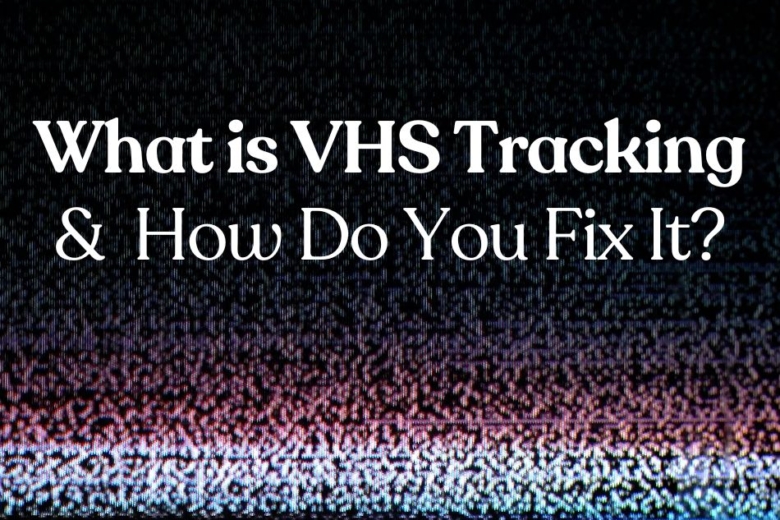If you’ve ever placed an old VHS tape into a VCR and seen those wobbly horizontal lines or flickering images come up on screen, then you’ve experienced VHS tracking problems firsthand — and know how frustrating it is.
In this post, we explain what VHS tracking is, why it causes problems, and how to fix it.
WHAT IS VHS TRACKING?
VHS tracking refers to the alignment between the video signal recorded on the tape and the playback heads inside the VCR. When that alignment is off, it causes static, warping, or those classic VHS tracking lines across the screen.
This misalignment often occurs because no two VCRs or tapes are exactly alike. Tiny differences in how a tape was recorded or how a machine reads the signal can throw things out of sync.
While VHS tracking distortion has become part of a nostalgic aesthetic (VHS tracking overlays and effects are sometimes used deliberately in digital video to mimic the look of vintage footage), these tape tracking issues are a lot less charming if you’re just trying to watch your old home movies.
COMMON VHS TRACKING PROBLEMS
Below are the most common issues if the tape’s signal doesn’t align properly with the VCR’s playback heads.
HORIZONTAL TRACKING LINES
Probably the most recognizable issue (and the one used when trying to replicate the nostalgic feel of tapes), VHS tracking lines are flickering or wavy bars. They’re usually at the top or bottom of the screen, but sometimes right across the middle.
PICTURE JUMPING OR ROLLING
If the image jitters, rolls vertically, or looks almost like it’s tearing, that’s a sign of poor tape tracking. It can feel like the video is struggling to stay in place, which makes watching it nearly impossible.
DISTORTED OR WARPED IMAGES
Sometimes tracking problems can manifest as warped on-screen images, like you’re watching a movie play out through a funhouse mirror.
FUZZINESS OR BLURRINESS
VHS tracking issues aren’t always so overt as bouncing or warped images. Sometimes, poor tracking can make the image look soft, out of focus, or like it has a constant grainy overlay. It’s often mistaken for bad resolution, but it is often caused by signal misalignment.
LOSS OF SOUND OR SPORADIC AUDIO DROPOUTS
Although VHS tracking mainly affects the image, it can impact the sound too. When tracking is misaligned, it can introduce noise, distortion, and even dropouts in the audio playback, especially on tapes with slower recording speeds like EP.
This is because the audio head on a VHS player reads the linear audio track; misalignment can cause the head to skip or misinterpret portions of the signal.
HOW TO FIX VHS TAPE TRACKING
Dealing with VHS tracking problems can be frustrating when you’re just trying to watch a video. The good news is that they’re usually fixable with just a few adjustments. Here’s how to fix VHS tape tracking and get a cleaner picture.
1. LET THE VCR HANDLE IT AUTOMATICALLY
Some VCRs have automatic tracking, which means they’ll adjust themselves as the tape plays. Try stopping and restarting the tape, or ejecting and re-inserting it. Giving the VCR a fresh start may help it find the best tracking position. If not, move on to step two.
2. USE THE TRACKING BUTTONS ON YOUR VCR
Most VCRs have manual tracking controls (look for “Tracking +” and “Tracking –” or just simple up/down arrows), which adjust the alignment between the tape and video heads. Try playing the tape and slowly pressing these buttons to see if it clears up the image.
3. TRY A DIFFERENT VCR
Tape tracking can vary between machines. If a tape plays poorly on one VCR, try it in another. A better or newer VCR might compensate for tracking issues more effectively.
4. CLEAN THE TAPE AND THE VCR
Dust and dirt can mess with VHS tracking, especially if the tape hasn’t been played in years. Use a VHS head-cleaning cassette to clean your VCR, then gently inspect the tape for visible dirt or mold.
5. FAST FORWARD AND REWIND THE TAPE
Before giving up on a tape, fully fast-forward and then rewind it. This can help loosen tight spools, even out the tape tension, and sometimes resolve minor VHS tracking problems just by getting things moving again.
6. DIGITIZE THE TAPE BEFORE IT GETS WORSE
If you’ve managed to get the picture looking decent, now’s a great time to digitize it. Analog tapes degrade over time, and tracking issues often get worse with age.
Fixing VHS tracking temporarily gives you a window to save your footage in a digital format, before it becomes unwatchable.
WHAT TO DO IF TAPE TRACKING CAN’T BE FIXED
Sometimes, no matter how much you adjust the tracking or clean the tape, the picture just won’t cooperate. That doesn’t mean you should give up on your tape! EverPresent’s VHS-to-digital services are here to help.
Our team uses professional-grade equipment and expertise to digitize videotapes, whether you have five videotapes or five thousand. Every tape is handled with the care we would give to our own home movies.
Get in touch today and let EverPresent bring your old tapes back to life… before it’s too late.

